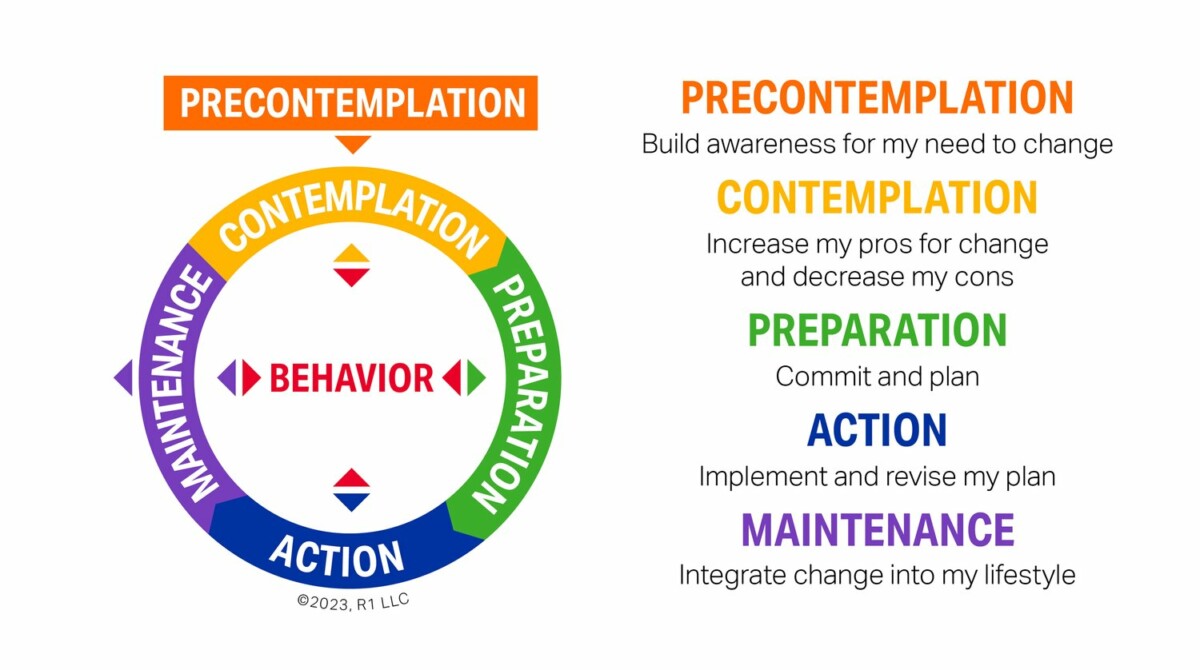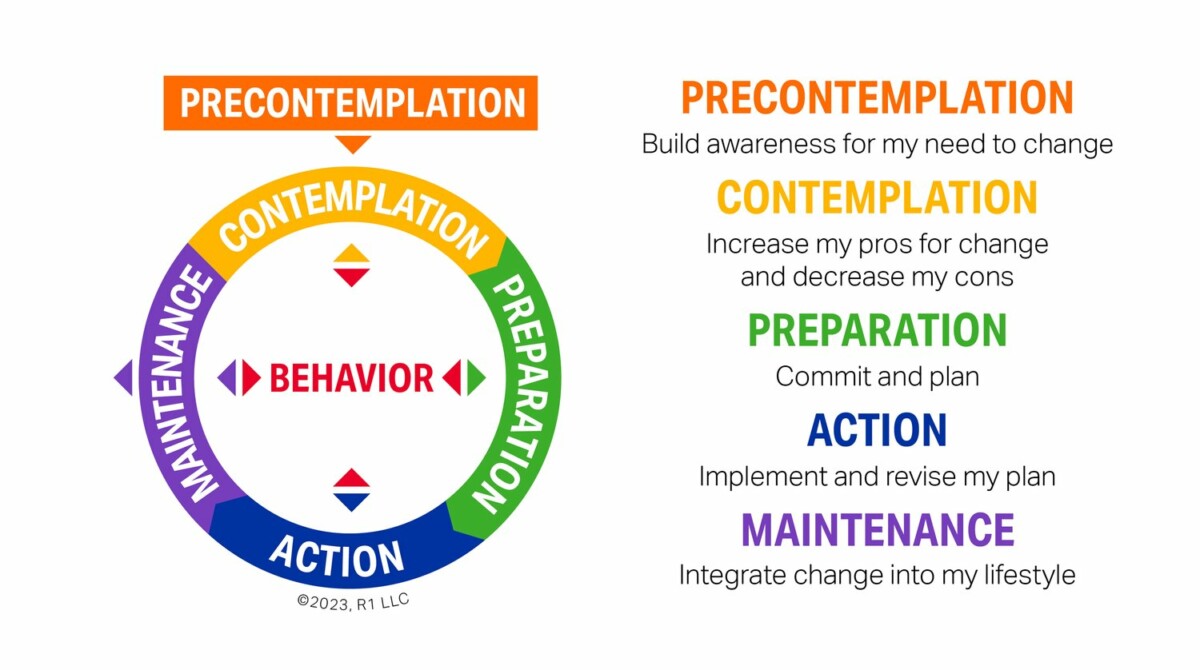Authored by: Jane Ling BScPhm.RPh., Elaine Ling PharmD., BSc., RPh. HC-PCP
To vape or not to vape? That ISN’T the question. The question is: Will pharmacists step up to help patients no matter where they are in their stage of change towards a healthier life?
The Stages of Change Model

With an ever-expanding scope of practice, pharmacists are often the first point of contact for any patient seeking help for their health concerns. Almost 70% of smokers say they want to quit.[2] With the legalization of e-cigarettes, and evolving areas regarding tobacco harm reduction, it can be challenging to navigate the gray when assisting patients.
On May 31st, 2023, the World Health Organization (WHO) and public health champions around the world will come together to celebrate World No Tobacco Day (WNTD).
To mark the event, Pharmacists for a Smoke Free Canada (PSFC) have released a new tool called the PSFC e-cig Nicotine Estimator Tool.
It was developed for healthcare practitioners to estimate the daily amount of nicotine vaped (mg/day) from an ENDS (Electronic Nicotine Delivery System) which is also called an e-cig, electronic cigarette or vape.
This tool will help pharmacists navigate these new emerging areas of tobacco harm reduction and vaping cessation.
1) PSFC e-cig Nicotine Estimator Form
2) PSFC e-cig Nicotine Estimator (mg) Downloadable Excel Tool
3) PSFC e-cig Nicotine Estimator (%) Downloadable Excel Tool
Jane Ling, President of PSFC, along with Dr. Leslie Phillips, PSFC VP (N.L.) have authored the tool and provided an accompanying short video webinar to explain how to use the PSFC e-cig Nicotine Estimator.
Learning Objectives include:
1) Describe the basic components of e-cigarettes, explain how they work, and identify the basic types of e-cigarettes currently available
2) Apply a systematic process to estimate the amount of nicotine a person is vaping on a daily basis (mg/day), using factors such as device type, e-liquid concentration, and frequency of use
3) Use a case-based scenario to estimate the daily nicotine amount vaped in various e-cigarettes
This 4-step tool breaks down the formula into an easy-to-use format to estimate daily e-cigarette nicotine vaped in mg/day:
STEP 1: e-cig Type
STEP 3: Nicotine Volume (mL/day)
STEP 2: Nicotine Concentration (mg/mL)
STEP 4: Nicotine per day (mg/day)
Since 2011, pharmacists in Ontario have had the authority to prescribe smoking cessation medications, varenicline and bupropion. Ontario pharmacists receive $125 annual remuneration through the Pharmacy Smoking Cessation Program for counselling Ontario Drug Benefits (ODB) and OHIP+ patients on their journey to become smoke-free.
The Ontario Pharmacists Association (OPA) provides an online training program called Implementing Smoking Cessation in the Pharmacy which certifies pharmacists in smoking cessation to allow for billing ODB for smoking cessation services.
The modules include:
Module 1: Pathophysiology
Module 2: How to Help Patients Quit Smoking
Module 3: Prescribing Pharmacotherapy
Module 4: Implementing Smoking Cessation in Your Practice
Module 5: Harm Reduction
Tobacco addiction is a chronic relapsing disease and is a risk factor for many chronic diseases including diabetes, hypertension, COPD, heart disease.[3] Smoking cessation is one of the most impactful and cost-effective preventative interventions in healthcare.[3]
On average, it can take several quit attempts, but in each quit attempt patients learn strategies, become more knowledgeable and move towards success. Quitting smoking is challenging for any patient but with pharmacists by their side assisting them on their long and winding road, it can greatly improve their chances of success.
Pharmacists are:
● the most accessible healthcare provider[4]
● one of the most trusted healthcare professionals
● an expert in medication management and treatment choices
PSFC have developed several tools, algorithms and videos to help pharmacists assist people on their journey to a smoke-free life. By using a combination of strategies including the 3A’s (Ask, Advise, Act) as well as motivational interviewing to gather patient history, pharmacists can work with patients to implement an effective, clinically suitable and sustainable smoking cessation plan.
These PSFC resources can be found online:
Canadian Pharmacist Smoking Cessation Pharmacotherapy Algorithm
1) PSFC Algorithm Initial Tool
2) PSFC Algorithm Follow Up Tool
3) PSFC Patient Quit Tool
Algorithme pharmacothérapie pour l’abandon tabagique
1) PCSF Algorithme d’évaluation initiale
2) PCSF Algorithme de suivi
3) PCSF Plan d’abandon pour le patient
In addition, Tobacco Harm Reduction and Vaping Cessation are two new emerging areas where patients are asking pharmacists for help. PSFC was a part of the development committee of:
1) Lower Risk Nicotine Use Guidelines (LRNUG) – Health Canada/CAMH
Nicotine is an extremely addictive substance that can be difficult to quit completely. For patients currently using or thinking of using nicotine products, LRNUG outlines modifiable behaviours and recommendations on the use of alternative nicotine products such as e-cigarettes. Pharmacists can share this Evidence Brief and Quick Tips page as a way to initiate conversation with patients who are looking to improve their health.
2) Vaping Cessation Resource Guide – CAMH
These guidelines provide considerations for approaches to vaping cessation. In addition to asking all patients if they are smokers, all patients should be asked if they vape. Some patients use both cigarettes and e-cigarettes, and may be eligible for up to 8 weeks of free Nicotine Replacement Therapy (NRT) as well as access to an online program designed to help with vaping cessation through the STOP on the Net Program. Take into account patient preference, their personal goals, and smoking history when developing a treatment plan.
With patients paying attention to their lung health now more than ever, pharmacists can help them navigate the changing landscape of smoking, tobacco harm reduction and vaping cessation. With all these new tools, pharmacists are poised to be leaders in assisting patients on their journey to a healthier smoke-free life. No one needs to be left behind.
REFERENCES
[1] TOM KARL. (June 2, 2020) https://r1learning.com/blog/2020/5-stages-of-change Accessed May 18, 2023
[2] Babb S, Malarcher A, Schauer G, Asman K, Jamal A. Quitting Smoking Among Adults—United States, 2000–2015. Morbidity and Mortality Weekly Report 2017;65(52):1457-64 Accessed May 18, 2023
[3] S. Department of Health and Human Services. Smoking Cessation. A Report of the Surgeon General. Atlanta, GA: U.S. Department of Health and Human Services, Centers for Disease Control and Prevention, National Center for Chronic Disease Prevention and Health Promotion, Office on Smoking and Health, 2020
[4] Valliant SN, Burbage SC, Pathak S, Urick BY. Pharmacists as accessible health care providers: quantifying the opportunity. J Manag Care Spec Pharm. 2022 Jan;28(1):85-90. doi: 10.18553/jmcp.2022.28.1.85. PMID: 34949110; PMCID: PMC8890748.


